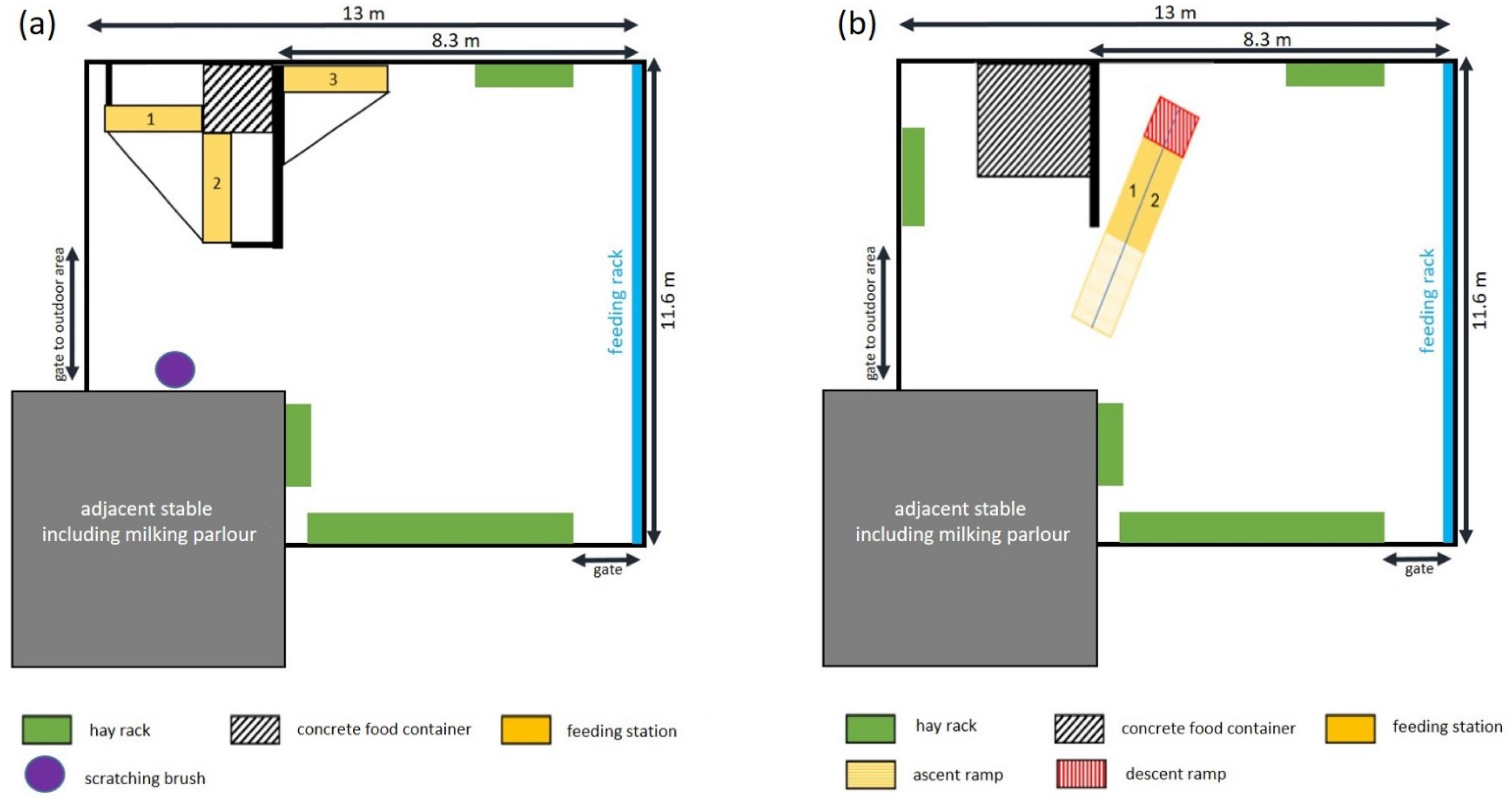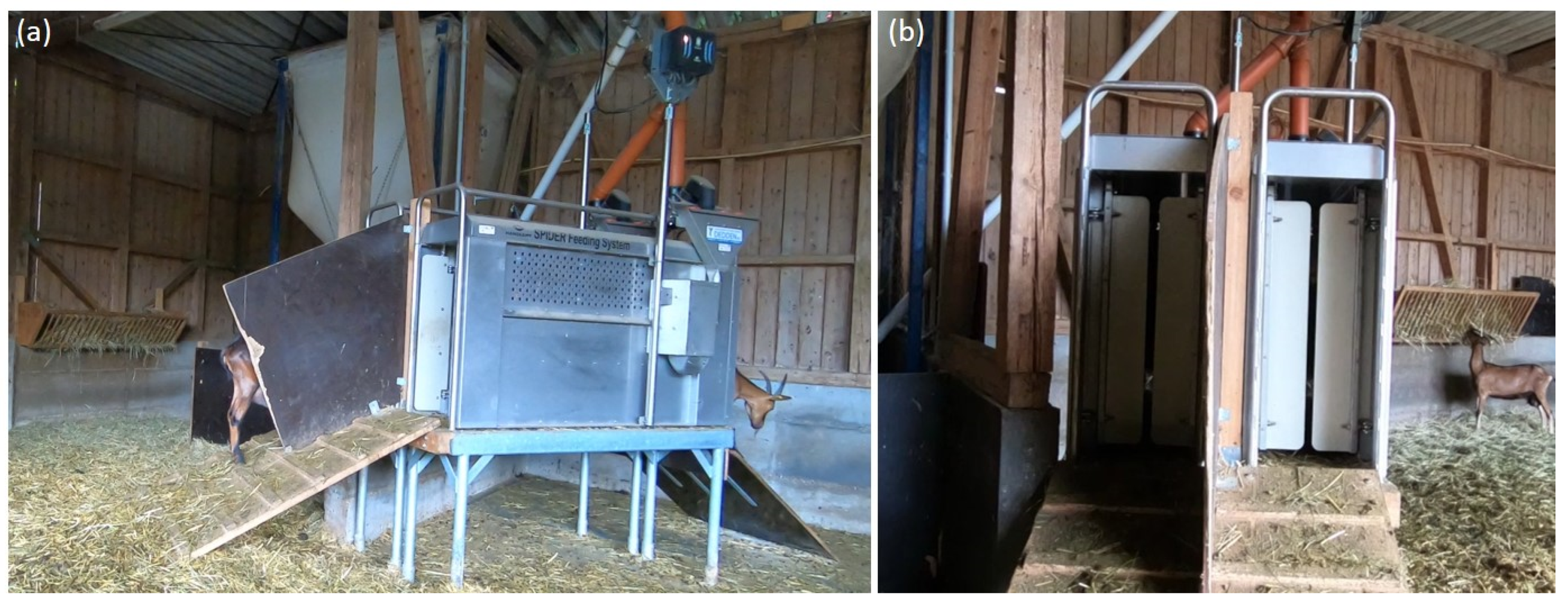Lying Behaviour in Dairy Goats: Effects of a New Automated Feeding System Assessed by Accelerometer Technology
Abstract
:Simple Summary
Abstract
1. Introduction
2. Materials and Methods
2.1. Animals, Housing and Management
2.2. Measurements
2.3. Statistical Analyses
- Lying time (h/d per goat) (LT), representing means of all daily lying times of all goats.
- Lying bout duration (h/bout) (LBD), representing (the mean) daily lying bout duration with start and end point of all goats.
- Frequency of lying bouts (n/d and goat) (FLB), representing means of all daily lying bouts of all goats.
3. Results
3.1. Video Data
3.2. Accelerometer Data
4. Discussion
4.1. Accelerometer Technique
4.2. Lying Parameters Comparatively Shown for Old and New AFS
4.2.1. Evaluated Lying Times Compared to Other Studies
4.2.2. Seasonal Progression of Lying Times
4.2.3. Effect of Horn Status on Lying Times
5. Conclusions
Author Contributions
Funding
Institutional Review Board Statement
Data Availability Statement
Acknowledgments
Conflicts of Interest
References
- Statistisches Bundesamt 2017, Ausgewählte Merkmale im Zeitvergleich-Statistisches Bundesamt. Available online: https://www.destatis.de/DE/Themen/Branchen-Unternehmen/Landwirtschaft-Forstwirtschaft-Fischerei/Landwirtschaftliche-Betriebe/Tabellen/ausgewaehlte-merkmale-zv.html (accessed on 27 May 2021).
- Statistisches Landesamt 2021, Entwicklung der Viehhaltung in landwirtschaftlichen Betrieben. Available online: https://www.statistik-bw.de/Landwirtschaft/Viehwirtschaft/Entw-VH.jsp (accessed on 27 May 2021).
- BDZ. Bundesstatistik Herdbuchbestand Ziegen; Bundesverband Deutscher Ziegenzüchter: Berlin, Germany, 2012. [Google Scholar]
- German Animal Welfare Act (Tierschutzgesetz) Version of May 18th 2006 (1313), Last Alteration of June 19th 2020 (1328), TierSchG-Tierschutzgesetz. Available online: https://www.gesetze-im-internet.de/tierschg/BJNR012770972.html (accessed on 27 May 2021).
- Barroso, F.G.; Alados, C.L.; Boza, J. Social hierarchy in the domestic goat: Effect on food habits and production. Appl. Animl. Behav. Sci. 2000, 69, 35–53. [Google Scholar] [CrossRef]
- Jørgensen, G.H.M.; Andersen, I.L.; Bøe, K.E. Feed intake and social interactions in dairy goats—The effects of feeding space and type of roughage. Appl. Animl. Behav. Sci. 2007, 107, 239–251. [Google Scholar] [CrossRef]
- Nordmann, E.; Keil, N.M.; Schmied-Wagner, C.; Graml, C.; Langbein, J.; Aschwanden, J.; von Hof, J.; Maschat, K.; Palme, R.; Waiblinger, S. Feed barrier design affects behaviour and physiology in goats. Appl. Animl. Behav. Sci. 2011, 133, 40–53. [Google Scholar] [CrossRef]
- Loretz, C.; Wechsler, B.; Hauser, R.; Rüsch, P. A comparison of space requirements of horned and hornless goats at the feed barrier and in the lying area. Appl. Animl. Behav. Sci. 2004, 87, 275–283. [Google Scholar] [CrossRef]
- Waiblinger, S.; Schmied-Wagner, C.; Nordmann, E.; Mersmann, D.; Szabo, S.; Graml, C.; von Hof, J.; Maschat, K.; Grubmüller, T.; Winckler, C. Haltung von Behornten und Unbehornten Milchziegen in Großgruppen; Endbericht zum Forschungsprojekt: Wien, Austria, 2010; 170p. [Google Scholar]
- Leitner, G.; Silanikove, N.; Merin, U. Estimate of milk and curd yield loss of sheep and goats with intrammamary infection and its relation to somatic cell count. Small Rumin. Res. 2008, 74, 221–225. [Google Scholar] [CrossRef]
- Neave, H.W.; Weary, D.M.; von Keyserlingk, M.A.G. Review: Individual variability in feeding behaviour of domesticated ruminants. Animal 2018, 12, 419–430. [Google Scholar] [CrossRef] [Green Version]
- Costa, J.H.C.; Cantor, M.C.; Neave, H.W. Symposium review: Precision technologies for dairy calves and management applications. J. Dairy Sci. 2021, 104, 1203–1219. [Google Scholar] [CrossRef]
- Neave, H.W.; von Keyserlingk, M.A.G.; Weary, D.M.; Zobel, G. Feed intake and behavior of goats when offered an elevated feed bunk. J. Dairy Sci. 2018, 101, 3303–3310. [Google Scholar] [CrossRef] [Green Version]
- Aschwanden, J.; Gygax, L.; Wechsler, B.; Keil, N.M. Structural modifications at the feeding place: Effects of partitions and platforms on feeding and social behaviour of goats. Appl. Anim. Behav. Sci. 2009, 119, 180–192. [Google Scholar] [CrossRef]
- Nordmann, E.; Barth, K.; Futschik, A.; Palme, R.; Waiblinger, S. Head partitions at the feed barrier affect behaviour of goats. Appl. Anim. Behav. Sci. 2015, 167, 9–19. [Google Scholar] [CrossRef]
- Tucker, C.B.; Jensen, M.B.; de Passillé, A.M.; Hänninen, L.; Rushen, J. Invited review: Lying time and the welfare of dairy cows. J. Dairy Sci. 2021, 104, 20–46. [Google Scholar] [CrossRef]
- Robert, B.; White, B.J.; Renter, D.G.; Larson, R.L. Evaluation of three-dimensional accelerometers to monitor and classify behavior patterns in cattle. Comput. Electron. Agric. 2009, 67, 80–84. [Google Scholar] [CrossRef]
- Ledgerwood, D.N.; Winckler, C.; Tucker, C.B. Evaluation of data loggers, sampling intervals, and editing techniques for measuring the lying behavior of dairy cattle. J. Dairy Sci. 2010, 93, 5129–5139. [Google Scholar] [CrossRef]
- Zobel, G.; Weary, D.M.; Leslie, K.; Chapinal, N.; von Keyserlingk, M.A.G. Technical note: Validation of data loggers for recording lying behavior in dairy goats. J. Dairy Sci. 2015, 98, 1082–1089. [Google Scholar] [CrossRef]
- Greiner, B.; von Korn, S.; Lutz, C.; Kamann, J.; Rees, O.; Sporkmann, K.; Georg, H.; Kern, A.; Bernau, M. Kraftfutterstation für behornte Ziegen. Schafzucht 2020, 23, 11–13. [Google Scholar]
- Tierschutz-Nutztierhaltungsverordnung 2021. Tierschutz-Nutztierhaltungsverordnung in der Fassung der Bekanntmachung vom 22. August 2006 (BGBl. I S. 2043), die Zuletzt Durch Artikel 1a der Verordnung vom 29. Januar 2021 (BGBl. I S. 146) Geändert Worden ist. (German Federal Ministry for Food, Agriculture and Consumer Protection). Available online: https://www.gesetze-im-internet.de/tierschnutztv/ (accessed on 22 July 2021).
- Zobel, G.; Leslie, K.; Weary, D.M.; von Keyserlingk, M.A.G. Ketonomia in dairy goats: Effect of dry period length and effect on lying behaviour. J. Dairy Sci. 2015, 98, 6128–6138. [Google Scholar] [CrossRef]
- Patt, A.; Gygax, L.; Wechsler, B.; Hillmann, E.; Palme, R.; Keil, N.M. Factors influencing the welfare of goats in small established groups during the separation and reintegration of individuals. Appl. Anim. Behav. Sci. 2013, 144, 63–72. [Google Scholar] [CrossRef]
- Fukasawa, M.; Komatsu, T.; Higashiyama, Y. Sleep and lying behaviour of milking Holstein cows at commercial tie-stall dairy farms. Anim. Sci. J. 2019, 90, 1313–1319. [Google Scholar] [CrossRef] [PubMed]
- Nordlund, K.V.; Strassburg, P.; Bennett, T.B.; Oetzel, G.R.; Cook, N.B. Thermodynamics of standing and lying behavior in lactating dairy cows in freestall and parlor holding pens during conditions of heat stress. J. Dairy Sci. 2019, 102, 6495–6507. [Google Scholar] [CrossRef]
- Bøe, K.E.; Andersen, I.L.; Buisson, L.; Simensen, E.; Jeksrud, W.K. Flooring preferences in dairy goats at moderate and low ambient temperature. Appl. Anim. Behav. Sci. 2007, 108, 45–57. [Google Scholar] [CrossRef]
- Angrecka, S.; Herbut, P. Impact of barn orientation on insolation and temperature of stalls surface. Ann. Anim. Sci. 2016, 16, 887–896. [Google Scholar] [CrossRef] [Green Version]
- Andersen, I.L.; Bøe, K.E. Resting pattern and social interactions in goats—The impact of size and organisation of lying space. Appl. Anim. Behav. Sci. 2007, 108, 89–103. [Google Scholar] [CrossRef]
- Vas, J.; Andersen, I.L. Density-Dependent Spacing Behaviour and Activity Budget in Pregnant, Domestic Goats (Capra hircus). PLoS ONE 2015, 10, e0144583. [Google Scholar] [CrossRef] [Green Version]
- Aschwanden, J.; Gygax, L.; Wechsler, B.; Keil, N.M. Loose housing of small goat groups: Influence of visual cover and elevated levels on feeding, resting and agonistic behaviour. Appl. Anim. Behav. Sci. 2009, 119, 171–179. [Google Scholar] [CrossRef]



| April 2019 | June 2019 | October/November 2019 | March/April 2020 | June 2020 | October 2020 | |
|---|---|---|---|---|---|---|
| Measurement period | 04.04–11.04. | 08.06–14.06. | 28.10–03.11. | 28.03–03.04. | 13.06–19.06. | 03.10–09.10. |
| Number of goats in the herd (n) | 76 goats | 72 goats | 64 goats | 72 goats | 67 goats | 65 goats |
| Horn status proportional in the herd | 41% horned 59% hornless | 42% horned 58% hornless | 44% horned 56% hornless | 56% horned 44% hornless | 58% horned 42% hornless | 57% horned 43% hornless |
| Number of goats per measurement (n) | 19 goats | 16 goats | 19 goats | 20 goats | 20 goats | 20 goats |
| Mean age of the evaluated goats (a) | 5.28 ± 3.82 | 4.28 ± 2.7 | 4.68 ± 2.71 | 5.21 ± 2.37 | 4.3 ± 3.01 | 4.35 ± 3.31 |
| Horn status of evaluated goats | 11 horned 8 hornless | 8 horned 8 hornless | 8 horned 11 hornless | 11 horned 9 hornless | 13 horned 7 hornless | 12 horned 8 hornless |
| Mean age of the evaluated goats by horn status (a) | horned: 3.09 ± 3.08 hornless: 7.75 ± 3.15 | horned: 2.63 ± 1.92 hornless: 5.88 ± 2.53 | horned: 2.75 ± 1.04 hornless: 6.09 ± 2.70 | horned: 3.36 ± 1.12 hornless: 7.11 ± 1.90 | horned: 3.00 ± 1.87 hornless: 6.71 ± 3.35 | horned: 2.83 ± 2.08 hornless: 6.63 ± 3.62 |
| Month | LT [h/d] | LBD [h] | FLB [n/d] | |||
|---|---|---|---|---|---|---|
| horned | hornless | horned | hornless | horned | hornless | |
| April 19 | 12.4 ± 0.44 | 11.4 ± 0.51 | 0.51 ± 0.03 a | 0.66 ± 0.03 b | 25.7 ± 1.46 a | 17.4 ± 1.71 b |
| June 19 | 10.8 ± 0.51 | 11.2 ± 0.51 | 0.38 ± 0.03 a | 0.47 ± 0.03 b | 29.6 ± 1.71 a | 24.4 ± 1.71 b |
| October 19 | 11.4 ± 0.51 | 12.0 ± 0.44 | 0.52 ± 0.03 | 0.52 ± 0.03 | 23.1 ± 1.71 | 24.3 ± 1.46 |
| Mean 2019 | 11.5 ± 0.28 | 11.6 ± 0.28 | 0.47 ± 0.02 a | 0.55 ± 0.02 b | 26.1 ± 0.94 a | 22.0 ± 0.94 b |
| April 20 | 12.3 ± 0.44 | 12.7 ± 0.48 | 0.55 ± 0.03 | 0.57 ± 0.03 | 22.6 ± 1.46 | 22.3 ± 1.61 |
| June 20 | 12.0 ± 0.40 | 11.5 ± 0.55 | 0.43 ± 0.02 | 0.43 ± 0.03 | 29.0 ± 1.34 | 27.3 ± 1.83 |
| October 20 | 11.4 ± 0.42 | 11.4 ± 0.51 | 0.52 ± 0.02 | 0.54 ± 0.03 | 23.0 ± 1.40 | 22.0 ± 1.71 |
| Mean 2020 | 11.9 ± 0.24 | 11.8 ± 0.30 | 0.50 ± 0.01 | 0.51 ± 0.02 | 24.9 ± 0.81 | 23.9 ± 0.99 |
Publisher’s Note: MDPI stays neutral with regard to jurisdictional claims in published maps and institutional affiliations. |
© 2021 by the authors. Licensee MDPI, Basel, Switzerland. This article is an open access article distributed under the terms and conditions of the Creative Commons Attribution (CC BY) license (https://creativecommons.org/licenses/by/4.0/).
Share and Cite
Maurmann, I.; Greiner, B.A.E.; von Korn, S.; Bernau, M. Lying Behaviour in Dairy Goats: Effects of a New Automated Feeding System Assessed by Accelerometer Technology. Animals 2021, 11, 2370. https://doi.org/10.3390/ani11082370
Maurmann I, Greiner BAE, von Korn S, Bernau M. Lying Behaviour in Dairy Goats: Effects of a New Automated Feeding System Assessed by Accelerometer Technology. Animals. 2021; 11(8):2370. https://doi.org/10.3390/ani11082370
Chicago/Turabian StyleMaurmann, Ines, Bianca A. E. Greiner, Stanislaus von Korn, and Maren Bernau. 2021. "Lying Behaviour in Dairy Goats: Effects of a New Automated Feeding System Assessed by Accelerometer Technology" Animals 11, no. 8: 2370. https://doi.org/10.3390/ani11082370
APA StyleMaurmann, I., Greiner, B. A. E., von Korn, S., & Bernau, M. (2021). Lying Behaviour in Dairy Goats: Effects of a New Automated Feeding System Assessed by Accelerometer Technology. Animals, 11(8), 2370. https://doi.org/10.3390/ani11082370







